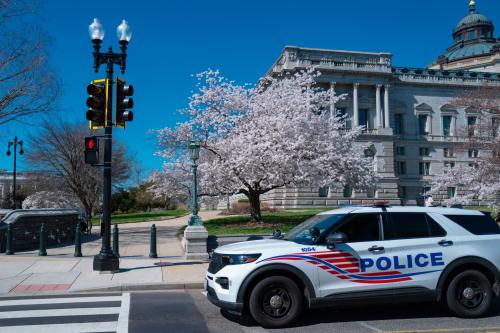On Tuesday, May 20, 2025, Andre Perry will speak on this subject and other findings from his book at the Capri Theater in Minneapolis.
Black Lives Matter—one of the largest protest movements in U.S. history—peaked in the aftermath of the 2020 murder of George Floyd, when half a million people participated in nearly 550 separate rallies throughout the country. If the protests were prompted by the police killings of unarmed Black people, they were fueled by the deeper, long-standing grievances of racial injustice across many realms of life.
The slogan “Black Lives Matter” sparked strong reactions, both positive and negative. To this day, people continue to debate and question its meaning. However, the visuals of Floyd’s killing made us all face the stark reality that the absence of power equates to death. True power, then, must include the ability to live fully, to flourish, and to thrive with dignity and security.
In my new book, “Black Power Scorecard: Measuring the Racial Gap and What We Can Do to Close It,” I define “Black power” as the ability to live out one’s natural life—one shaped by dignity, safety, and opportunity. I use life expectancy as a proxy of Black power and justice, measuring not merely the numbers of years one lives but using it as an indicator that reflects much more. It captures how the cumulative impact of persistent structural inequality cuts lives short. It reflects denied opportunities and unrealized potential.
Identifying what helps people thrive is critical for building policies that address not only immediate harms, but also everyday conditions that support well-being and contribute to longevity. Access to affordable housing, health care, education, clean air, economic security, and personal and communal safety all shape well-being, extend life expectancy, and provide an enabling environment for a higher quality of life.
The summer of 2020 made clear that people can rally around collective trauma. Acts of civil disobedience, when targeted, are effective in disrupting and demanding attention. But rallies eventually dissipate. People return to work, parents send their children to school, and daily life ensues. In order to drive durable change, civil unrest must transform into civic action. In my book, I argue that civic action must be anchored in legislation that advances a multidimensional and positive vision of what communities need in order to thrive.
Past and present discrimination continue to erode the quality of life for Black people, and there is still a desperate need for policies that work for all Americans. DEI, affirmative action, and environmental, social, and governance programs have never been the goals of the Civil Rights Movement. These movements can raise awareness and symbolize a cry for help, but they are certainly not ends in themselves. The true endpoint has always been securing legislation focused on rights, protections, and investments that ensure long lives and well-being. Tactics will change, but Black power must be gained alongside racial justice in order to increase longevity and provide restitution for the compounded damages of discrimination. Yet legislation since the civil rights era of the 1950s and 1960s has largely failed to address widening racial gaps in income, wealth, and homeownership for Black communities.
Black people know what we are fighting against, but what are we fighting for? Facing a real retrenchment of basic civil rights protections, the next civil rights push must rally around a bold and clear vision—one anchored in the conditions that enable Black Americans to live out their natural lives. In this context, life expectancy is not just a statistic, but a symbol of the gap between the life one is born with the potential to live and the life cut short by systemic factors rooted in generations of racial discrimination. To fully realize life expectancy for Black Americans, we must transform structures that have historically made Black lives more vulnerable and less valuable.
Five years since Floyd’s murder, the Black Lives Matter movement has led to a barrage of performative gestures while failing to deliver any meaningful results for Black communities. The rate of police killings of Black people is unchanged, according to data compiled by the police reform organization Campaign Zero. And in a Pew Research Center survey, 72% of respondents said the increased focus on race and racial inequality after Floyd’s killing did not lead to meaningful changes that improved the lives of Black people.
The Trump administration is delivering on its campaign promise to dismantle what it deems as illegal DEI programs in the public and private sector. Executive orders aimed at federal departments, non-federal public and private sector entities, and protections for LGBTQIA individuals serve as the tip of spear, ending or severely weakening federal equity programs and producing a chilling effect among organizations and firms focused on the democratic values of racial equity, inclusion, and fairness.
Yet because executive orders do not have the force of law and are limited in scope to designated federal agencies, they cannot impose binding obligations on entities outside the federal government. The use of government power beyond what is constitutionally allowed is described as “federal overreach.” Civil rights groups, particularly legal ones, are obligated to defend against such overreach. Lawyers take an oath to defend the rule of law and uphold the Constitution in defense of democratic values.
Unlike our lawyer counterparts, policy researchers and advocates do not take such an oath, but we are no less obligated to advance basic principles of democracy, including diversity, equity, and inclusion. As lawyers do the work of defending the Constitution against federal overreach, policy advocates must work in service of advancing legislation that enshrines diversity, equity, and inclusion into law.
The empirical foundation for my book comes from ranking hundreds of variables from diverse sources—including the Census Bureau, Internal Revenue Service, Federal Reserve, Facebook, Redfin, Social Capital Project, County Health Rankings, and the Centers for Disease Control and Prevention—to identify the important factors associated with life expectancy. After running the model, we identified 13 key variables across five categories: wealth, human and social capital, family, safety, and environmental quality.
The next chapter of the Civil Rights Movement must offer concrete policy solutions that address the structural determinants of well-being such as home and business ownership, income, immigration, health education, environmental quality, family, and safety. Civil rights leaders must have an offensive strategy grounded in the most important factors that enable thriving.
We still need a strong defense of the principles of democracy, which are being attacked under the guise of removing “illegal DEI.” But the fear is that the broader electorate is increasingly willing to exchange basic democratic freedoms for the illusion of economic self-sufficiency and the promise of goods and services that a healthy democracy should otherwise provide.
Many Americans believe in the American Dream and what it’s supposed to offer: the opportunity to own a home and business, good schools, financial security, and social freedom. Yet across the racial and political spectrum, many feel that dream is unattainable, leaving them desperate for alternatives. What some of us see as authoritarianism, everyday people see as an opportunity for change. However, the promise of material prosperity cannot be disengaged from democratic principles of equity and inclusion, especially in a society where the playing field is unequal and access to opportunity is determined by race, ZIP code, wealth, and history. Economic prosperity that is disconnected from democratic values will only reinforce inequality rather than mitigating it.
To be clear, many Americans unashamedly do not support racial equality. White supremacists and other hate groups often harbor a distorted belief that democracy should only apply to their group. Over time, this thinking has become a kind of social gravity. America has become accustomed to accepting certain levels of authoritarianism. This is visible in our legacy of slavery, Jim Crow racism, and the continued presence of its vestiges such as single-family zoning, housing discrimination, and unequal education funding systems.
There is a defense against racism, and it runs through legislative change directed by legal and policy advocacy combined with public activism. However, that is not a substitute for an offense, which must offer a bold vision for how all Americans can thrive, grounded in equity, inclusion, fairness, justice, and shared prosperity for all.
The Brookings Institution is committed to quality, independence, and impact.
We are supported by a diverse array of funders. In line with our values and policies, each Brookings publication represents the sole views of its author(s).



Commentary
Five years since George Floyd, the new Civil Rights Movement needs to play offense
May 19, 2025